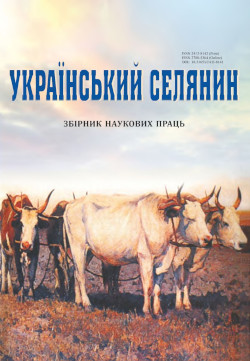Salary of peasant self-government offi cers in Right-bank Ukraine at the end of the 19th – early 20th century
Main Article Content
Abstract
The purpose of the article is an attempt to deepen and generalize knowledge about the financial support of
peasant self-government workers at the end of the 19th and the beginning of the 20th centuries.
The scientific novelty of the research results lies in the comprehensive study of the issue of financial support for workers of peasant self-government using materials not previously introduced into scientific circulation. Employees of peasant administrations received wages that not equal to their workload. For example, a peasant scribe received a lower salary than his colleague in any other state institution. And despite the low salary, the scribe in the peasant administration performed the function of clerk and accountant. It is obvious that the workers of the peasant administrative apparatus demanded a higher salary. However, rural communities did not want to increase their expenditure on administration financing. It is obvious that the workers of the peasant administration demanded a higher salary. For a long time, this issue was the subject of disputes between the leadership of the villagers and the community, sometimes disputes turned into conflicts. However, later the employees of the parish office realized that they are part of the state administration and therefore the state should pay them for their work.
Methodology. A historical-comparative method was used in the study of the problem of financial support for employees of peasant self-government. In particular, comparing the income of office workers of state institutions with the wages of employees of peasant self-government, it was established that with the same workload, employees of peasant administrations received less annual maintenance. Using the historical-systemic method, it was possible to find out why some peasant communities with a smaller population and villages could allocate more funds for the maintenance of peasant self-government than other peasant communities with a larger number of inhabitants.
Author’s conclusions. Among the employees of the peasant administrations, the scribe received the highest salary, the
same as the scribe or even less was paid to the head of the administration, tax collectors, village elders, judges could receive money for their work, or serve free of charge, as a natural duty. The amount of payments was set by the village community during the meeting. Considering the low solvency of the peasants, they could not pay the proper maintenance for the workers of the peasant self-government. Although the employees of the peasant administrations were not passive and appealed to the
provincial leadership with a request to transfer them to state support, the status of all employees of the peasant self-government remained unchanged, and their earnings continued to depend on the decisions of the peasant assembly.
Article Details
References
Barmak, M. (2016). Formuvannia rosiiskoi imperskoi systemy derzhavnoi sluzhby na ukrainskykh zemliakh (XVIII – XIX st.). [The formation of the Russian imperial system of civil service on Ukrainian lands (XVIII-XIX centuries)]. Ternopil. [in Ukrainian].
Bondarevskyi, A. (1961). Volosne upravlinnia ta stanovyshche selian na Ukraini pislia reformy 1861 roku. [Volost administration and situation of peasants in Ukraine after the 1861 reform].Kyiv. [in Ukrainian].
Verkhovtseva, I. (2018). Mizh korporatyvnistiu i biurokratyzmom: samovriaduvannia selian u Rosiiskii imperii (druha polovyna XIX – pochatok XX st.). [Between corporatism and bureaucracy: peasant self-government in the Russian Empire (second half of the 19th–early 20th centuries)]. Cherkasy. [in Ukrainian].
Ivanova, N., Zheltova, V. (2010). Soslovnoe obshchestvo Rossiiskoi imperii. [Class society of the Russian Empire]. Moskva. [in Russian].
Kasian, A. (2017). Volosne upravlinnia na Pravoberezhnii Ukraini (1861 – 1917 rr.). [Volost administration in Right Bank Ukraine (1861–1917)]. Candidat’s thesis. Cherkasy. [in Ukrainian].
Lozovyi, V. (2008). Ahrarna revoliutsiia v Naddniprianskii Ukraini: stavlennia selianstva do vlady v dobu Tsentralnoi Rady (berezen 1917 r. – kviten 1918 r.). [The agrarian revolution in Trans-Dnieper Ukraine: the attitude of the peasantry to the authorities during the time of the Central Rada (March 1917 - April 1918]. Kamianets-Podilskyi. [in Ukrainian].
Melnychuk, K. (2021). Selianske samovriaduvannia na Pravoberezhzhi Ukrainy u druhii polovyni XIX – na pochatku XX st. : formuvannia kadrovoho skladu. [Peasant self-government on the Right Bank of Ukraine in the second half of the 19th and early 20th centuries: the problem of personnel formation]. [Ukrainskyi istorychnyi zhurnal]. [Ukrainian Historical Journal]. Kyiv: TOV «DIA». №3. [in Ukrainian].
Melnychuk, O. (2001). Administratyvnyi aparat ta orhany mistsevoho samovriaduvannia na Podilli u druhii polovyni XIX stolittia. [Administrative apparatus and local self-government in Podillya in the second half of the 19th century]. Vinnytsia. [in Ukrainian].
Mironov, B. (2003). Sotsialnaya istoriya Rossii perioda imperii (XVІІІ – nachalo XX v.). [Social history of Russia during the empire period (18th–early 20th centuries)]. Sankt-Peterburg. [in Russian].
Mykhailiuk, O. (2007). Selianstvo Ukrainy v pershi desiatylittia XX st.: Sotsiokulturni protsesy. [The peasantry of Ukraine in the fi rst decades of the 20th century: Sociocultural processes]. Dnipro. [in Ukrainian].
Mykhailiuk, O. (2018). Koruptsiia v selianskomu seredovyshchi kintsia XIX – pochatku XX st. [Corruption in the peasant environment of the late 19th and early 20th centuries]. [Pytannia ahrarnoi istorii Ukrainy]. [Issues of agrarian history of Ukraine]. Dnipro: LIRA. [in Ukrainian].
Prysiazhniuk, Yu. (2007). Ukrainske selianstvo Naddniprianskoi Ukrainy: sotsiomentalna istoriia druhoi polovyny XIX – pochatku XX st. [The Ukrainian peasantry of Dnieper Ukraine: socio-mental history of the second half of the 19th - beginning of the 20th century]. Cherkasy. [in Ukrainian].
Reient, O. (2006). Sotsialne zhyttia v Ukraini v druhii polovyni XIX – na pochatku XX st. Istoriia ukrainskoho selianstva. [Social life in Ukraine in the second half of the 19th and early 20th centuries], Kyiv, 1. [in Ukrainian].
Reient, O. (2021). Sotsialno-ekonomichni ta politychni transformatsii v Ukraini (kinets XVIII – pershi desiatylittia XX st.). [Socio-economic and political transformations in Ukraine (the end of the 18th - the fi rst decades of the 20th century)]. Narys v 2-kh knyhakh. Kn. 2. [Essay in 2 books. Book 2.]. Kyiv. [in Ukrainian].

